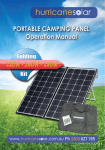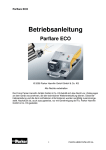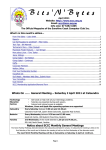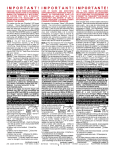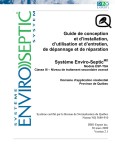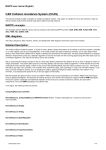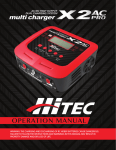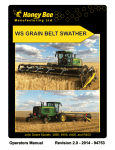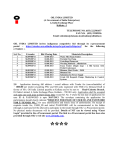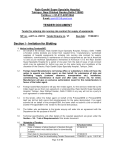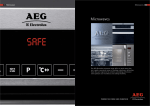Download E-S Generic Installation Manual 3-18-03
Transcript
Advanced Enviro-Septic™ (AES) Wastewater System Design & Installation Manual The onsite wastewater system sweeping the industry (AES) - Advanced Enviro-Septic Systems Design and Installation Manual Preview 2011 RJC Purpose The purpose of this manual is to provide guidance in the design and installation of septic leaching systems using the Presby Environmental, Inc., group of products. Presby Environmental, Inc., standards All systems using Advanced Enviro-Septic® products must be designed and installed in compliance with the procedures and specifications described in this manual. State VWDQGDUGV Advanced Enviro-Septic® when used as directed meets all the standards for Domestic use in the subsurface disposal of wastewater. In this manual This manual contains the following subjects. Section A – Introduction B – Definitions of Terms C – Design Criteria D – Installation, Handling, and Storage Guidelines E – Sand and Fill Requirements F – Single Level System Configurations G – Multi-LevelTM System Configurations H – Non-Conventional System Configurations I – Pump System Requirements J – Venting Requirements K – Bottom Drain Requirements L – Simple-Septic® Leaching Systems M – System Rejuvenation and Expansion Page 2 4 7 8 11 12 25 30 32 33 35 36 37 Use of attachment required This manual requires the use of an attachment specific to your State or Province in order to properly design and install Advanced Enviro-Septic® systems. Technical support Action Tanks Industries, provides technical support to all individuals using Presby Environmental products. For questions about products or the information contained in this manual, please contact us at 07-54424242 1 Section A Introduction Background Liquid that exits from a septic tank (effluent) contains suspended solids that can cause other types of septic systems to fail prematurely. Solids can overload bacteria, cut off aeration required for bacterial activity, and/or seal the underlying soil. Our unique system components The Advanced Enviro-Septic® System is a product consisting of three components. What our system does By utilizing simple, yet effective, natural processes the Advanced EnviroSeptic® System treats septic tank effluent in a manner that prevents solids from entering surrounding soils, increases system aeration, and provides a greater bacterial area (mat) than traditional systems. 1. A corrugated, perforated, high-density plastic pipe with a unique series of ridges on the peak of each corrugation and plastic “skimmers” extending into the pipe’s interior. 2. A thick mat of randomly oriented plastic fibers surrounding the pipe. 3. A special non-woven geo-textile plastic fabric around the mat of fibers. Why our system The Advanced Enviro-Septic® System retains solids in its pipe and provides excels multiple bacterial surfaces to treat effluent prior to its contact with the soil. The continual cycling of effluent (the rising and falling of liquid inside the pipe) enhances bacterial growth. No other leaching system design offers this functionality. Our systems excel because they are more efficient, last longer, and have a minimal environmental impact. System advantages Here’s a brief list of the advantages of The Advanced Enviro-Septic® System . • • • • • • • • • • • • Costs less than traditional installation products and materials Requires a smaller area Eliminates “septic mounds” through sloping system installations Adapts to difficult sites Requires less fill Installs more easily and quickly than traditional systems Eliminates the need for expensive washed stone Adapts easily to both commercial and residential sites Uses a protected receiving surface Increases system performance and longevity Tests environmentally safer than conventional systems Recharges groundwater more safely than conventional systems Continued 2 Introduction, Continued Here’s a cross sectional diagram of Advanced Enviro-Septic® System ® pipe. What it looks like TOP SOIL 6 GEO-TEXTILE FABRIC 5 COARSE FIBERS SEWN SEAM 3 SKIMMERS 9 7 8 AIR SPACE 2 SCUM 1 EFFLUENT 2 4 RIDGES SLUDGE CORRUGATED PLASTIC PIPE WITH EXTERIOR RIDGES SAND ORIGINAL SOIL How it works These are the basic stages that take effect in the Advanced Enviro-Septic® System Stage What Happens 1 Warm effluent enters the pipe and is cooled to ground temperature. 2 Suspended solids separate from the cooled liquid effluent. 3 Skimmers further capture grease and suspended solids from the effluent as it exits through perforations in the pipe. Pipe ridges allow the effluent to flow uninterrupted around the 4 circumference of the pipe and aid in cooling. A mat of random, coarse fibers separates more suspended solids 5 from the effluent. Effluent passes into the geo-textile fabric and grows a protected 6 bacterial surface. Sand wicks the liquid from the geo-textile fabric and enables air to 7 transfer to the bacterial surface. Fabric and fibers provide a large bacterial surface to break down 8 solids. An ample air supply and fluctuating liquid levels increase bacterial 9 efficiency. 3 Section B Definitions of Terms Introduction As you read through the information in this manual, you will encounter common terms, terms that are common to our industry, and terms that are unique to Advanced Enviro-Septic®(AES) systems. While alternative definitions LVPD\H[LVWWKsection defines these terms as they are used in this manual. List of terms Here’s a list of the terms defined in this section. • Basic system • Bottom drain • Center-to-center spacing • Combination system • Coupling • Design flow • D-box • Differential venting • Distribution box • Distribution box manifold • Double offset adapter • Drain sump • Drop connection • End cap ® • Enviro-Septic pipe • Equalizer™ • LPD • High and Low Oxygen Demand Vent (ODV) • High flow • Level system • Line • Low flow • Multi-Level™ system • Offset adapter • • • • • Raised connection Section Serial distribution Simple-Septic® pipe Sloping system Basic system A is a system consisting of one section of Advanced Enviro-Septic® pipe. Bottom drain A bottom drain is a pipe connecting the end of a line to a drain sump. Continued 4 Definitions of Terms, Continued Center-to-center Center-to-center spacing is the horizontal distance from the center of one line spacing to the center of the adjacent line. Combination system A combination system is a system incorporating two or more sections of Enviro-Septic® pipe, each section receiving effluent from a distribution box. Coupling A coupling is a fitting that joins two pieces of Advanced Enviro-Septic® pipe. D-Box D-Box is an abbreviation for distribution box. Design flow Design flow is the determined LPD flow as dictated by State and/or local code or rule. Differential venting Differential venting is a method of venting an Advanced Enviro-Septic® system utilizing high and low vents.(Oxygen Demand port) Distribution box A distribution box is a device used to divide and/or control effluent flow. Distribution box A distribution box manifold is a method of joining any number of distribution manifold box outlets to a single pipe. Double offset adapter A double offset adapter is an end cap with two offset holes. Drain sump A drain sump is a watertight chamber connected to the end of a bottom drain line. Drop connection A drop connection is a PVC pipe arrangement used to connect different levels of Advanced Enviro-Septic® pipe used in Multi-LevelTM systems. End cap An end cap is a solid cap used to seal the end of an Advanced Enviro-Septic® pipe. Enviro-Septic® pipe An Advanced Enviro-Septic® pipe is a single unit of pipe, 3m in length with an outside diameter of 300mm and a storage capacity of approximately 220 litres. Equalizer™ An Equalizer™ is a plastic insert installed in the outlet lines of a distribution box to provide more equal effluent distribution to each outlet. LPD LPD is an abbreviation for litres per day. Continued 5 Definitions of Terms, Continued High and low vents 2'9 High and low 2'9vents are pipes used in differential venting. High flow High flow is the minimum “design flow” requiring combination or distribution box system designs. Level system A level system is a system in which lines of Advanced Enviro-Septic® are installed at the same elevation. Line A line is a number of Advanced Enviro-Septic® pipes connected by couplings with an offset adapter on the inlet end and an offset adapter or end cap on the opposite end. Low flow Low flow is any “design flow” lower than “high flow.” Multi-Level system TM A Multi-LevelTM system is a patented system consisting of at least two levels of Advanced Enviro-Septic® pipe separated by sand. Offset adapter An offset adapter is an end cap fitted with a 100mm offset hole at the 12 o’clock position. Presby Maze® A Presby Maze® is a plastic unit that traps suspended solids and pre-treats septic tank effluent inside a septic tank. Raised connection A raised connection is a PVC pipe arrangement used to connect lines of Advanced Enviro-Septic® pipe to maintain the correct liquid level inside each line. Section A section is a group of Advanced Enviro-Septic® lines in serial distribution receiving effluent from a distribution box in a combination system. Serial distribution A serial distribution is a group of Advanced Enviro-Septic® lines* connected with a raised and/or drop connection. *See “line” in this section. Simple-Septic® pipe A Simple-Septic® pipe is a product identical to Advanced Enviro-Septic® with the exception of the thick mat of randomly orientated plastic fibers between the corrugated plastic pipe and the geo-textile fabric. Sloping system A sloping system is a system in which lines of Advanced Enviro-Septic® are installed atdifferent elevations. 6 Section C Design Criteria Introduction This page discusses general design criteria. Line orientation Advanced Enviro-Septic® lines must be laid level and should run parallel to contours (perpendicular to sloping terrain) if possible. Longer lines preferable In general, fewer long lines are preferable to a greater number of short lines. Longer lines provide more efficient settling of solids. In addition, longer more narrow systems reduce the potential for ground water mounding. Minimum/maxi- To maintain efficient effluent cycling, the minimum length of an Advanced Enviromum line Septic® line should be 9m and the maximum length 30m. In some instances lengths site conditions may require shorter or longer lengths. Reference: See Section H, “Non-Conventional System Configurations.” 3 meter It is easier for the installer if systems are designed in 3m increments since increments work Advanced Enviro-Septic® pipe is 3m in length. However, the pipe is easily cut to best any length necessary with a sharp knife. Line elevations For sloping systems it is helpful to provide elevations on the design for each line of the system. Septic tank and The outlet of a septic tank or D-Box must be set at least 50mm above the highest D-Box elevations inlet of the Advanced Enviro-Septic® line. Depth and types While most installations should avoid a cover depth of more than 450mm, some of cover conditions will require exceeding this limit. In particular, Advanced Enviro-Septic® systems with paved cover and/or vehicular traffic require a minimum of 450mm of cover along with appropriate venting. Reference: See Section J, “Venting Requirements.” Provide notes Designers should add homeowner notes to their designs regarding system use for homeowners and maintenance. Notes should include topics such as abusive substances, additives, constant discharge, etc. Suggested tank pumping and inspection schedules would also be beneficial. See State requirements Local and State jurisdictions may require additional design specifications. 7 Section D Installation, Handling, and Storage Guidelines Introduction This page contains guidelines that must be observed while installing, handling, and storing Enviro-Septic® products. Site preparation Here are some site preparation guidelines. • • • • • • Remove topsoil, roots, and organic matter under the required sand area of a proposed system, including the slope extensions of raised systems. Maintain the existing characteristics of the underlying soil as much as possible. Add the sand fill on the same day that the leach area is excavated. Do not allow water to run into or over the system during construction. Do not work wet or frozen soils. Do not smear or compact soils while preparing site. Note: It is not necessary for the leach area to be smooth when the site is prepared. System components Here’s a picture of the Enviro-Septic® components. Contamination Note: Keep mud, grease, oil, etc., from all system components. Avoid dragging pipe through wet or muddy areas. Continued 8 Installation, Handling, and Storage Guidelines, Continued Raised connections consist of offset adapters, 100mm PVC pipe and pipe elbows. They enable greater liquid storage capacity and increase the bacterial surfaces being developed. Use raised connections to connect lines of Enviro-Septic® pipe. Here is a diagram along with some installation notes. Use raised connections Installation Notes: 1. Insert PVC pipe no more than 100mm into the offset adapter to prevent air locking. 2. Install the raised connection so that the top of the 90° bend is level with the top of the offset adapter. 3. Pack sand under and around the raised connection to prevent movement. OFFSET HOLE TOP VIEW SIDE VIEW ENVIRO-SEPTIC PIPE END VIEW LEVEL 90 PVC Bend PPPVC Pipe OFFSET ADAPTER MAX. 4" OFFSET ADAPTER 4" PVC Pipe 90 PVC Bend While sand may be used to keep pipe in place while covering, simple tools may also be constructed for this purpose. Here are two examples. One is made from rebar, the other from wood. Line spacers Wooden frame Welded Rebar handle Bent Rebar Pipe Caution: Remove all tools used as line spacers before final covering. Continued 9 Installation, Handling, and Storage Guidelines, Continued Soil compaction Minimize machine movement to avoid soil compaction and destruction of the soil structure under and around the system. Be especially careful not to compact soil on the down slope side of the system. Backfilling and final grading Spread a minimum of 150mm of system sand over the pipe. Spread the remaining fill. Final grading should shed water away from the system. Note: A tracked vehicle may be used to spread the system sand and topsoil as long as it maintains at least 300mm of cover over the pipe. Erosion control Protect the site from erosion by proper grading, mulching, seeding, and control of runoff. Storage The outer fabric of the Advanced Enviro-Septic® pipe is ultra-violet stabilized. However, the protection breaks down after a period of time in direct sunlight. To preventdamage to the fabric, cover the pipe with an opaque tarp. Store pipe on high and dry areas to prevent surface water and soil from entering the pipes or contaminating the fabric prior to installation. 10 Section E Sand and Fill Requirements Introduction This page describes the sand and fill requirements for the Advanced Enviro-Septic® Leaching System. System sand All configurations of Advanced Enviro-Septic® require a minimum of 6” of system sand surrounding the circumference of the pipe. This sand, typically gravelly coarse sand, must adhere to the following percentage and quality restrictions. Percentage Restrictions 35% or less of the total sand may be gravel. 40%-90% of the total sand is to be coarse and very coarse sand. Gravel Quality Restrictions No gravel is to exceed ¾” in diameter. No gravel is smaller than 2mm/.0787” in diameter. Coarse Sand Quality Restrictions No coarse sand is smaller than 0.5mm/.0196” in diameter. Fines Quality Restrictions No more than 2% of the total sand may pass through a 75 µm sieve. ASTM Standard: C-33 (concrete sand) meets the above requirements. Sand fill and clean fill Sand fill is the material used to surround the system sand. Note: System sand may also be used as sand fill. Clean fill is the material used to complete the system. Raised system fill extensions Raised systems require fill extensions. Perimeter sand requirements Systems sloping 10% or less require the system sand and sand fill area to extend a minimum of 300mm around the perimeter of the Enviro-Septic® pipe. Reference: See “Raised systems fill extensions” in your State attachment. Systems sloping greater than 10% require the system sand and sand fill area to extend a minimum of 300mm on three sides and 1.2m beyond the Enviro-Septic® pipe on the down-slope side. 11 Section F Single Level System Configurations Preview Introduction Advanced Enviro-Septic® systems may be designed in a variety of unusual shapes such as curved, trapezoidal, or L-shaped to provide optimum design flexibility to address the challenges of each site. Reference: See Section H, “Non-Conventional System Configurations.” Low flow systems Low flow systems may use any of the configurations described in this section. High flow systems High flow systems must be designed as combination systems or distribution box systems. Reference: See “Low Flow” In your State attachment. Reference: See “High Flow” In your State attachment. Sloping systems The percentage of slope refers to the slope of the Advanced Enviro-Septic® system, notthe existing terrain. The slope of the system and the existing terrain are not required to be equal. A sloping system can be designed with more than one distinct slope and/or center-to-center pipe spacing in the same system. Maximum slope percentages are governed by jurisdiction specifications. Reference: See the “Single Level Quick Reference Guide” in your State attachment. Line orientation Enviro-Septic® lines must be laid level and should run parallel to contours (perpendicular to sloping terrain) if possible. Velocity reduction/ EqualizerTM If piping from the septic tank to Advanced Enviro-Septic® is excessively steep, a velocity reducer at the system inlet is necessary. A distribution box with a baffle or an inlet tee may be an adequate velocity reducer. Note: An EqualizerTM is limited to a maximum of 38ltr /minute in gravity systems and 76litres/minute in pumped systems. In this section This section contains the following subjects. Subject Basic Serial Systems – Level In-Ground, Level Raised, InGround Sloping, and Raised Sloping Distribution Box Systems – Level In-Ground, Level Raised, In-Ground Sloping, and Raised Sloping Combination Systems – Level In-Ground, Level Raised, InGround Sloping, and Raised Sloping Trench Systems – Basic Serial and Distribution Box 12 Page 13 16 20 24 Basic Serial Systems – Level In-Ground, Level Raised, InGround Sloping, and Raised Sloping Introduction This page shows basic serial distribution systems in level in-ground, level raised, in-ground sloping, and raised sloping configurations. Definition A basic serial system is a series of lines of Advanced Enviro-Septic® connected by raised connections. Serial diagram Here’s a top view of lines of pipe in a serial configuration. OFFSET ADAPTER ENVIRO-SEPTIC PIPE INLET RAISED CONNECTION COUPLING END CAP Level in-ground Here are end and top views of a level in-ground system. MIN. 1' SAND FILL OR SYSTEM SAND MIN. 1' W O.G. & F.G. C SYSTEM SAND ORIGINAL SOIL RESTRICTIVE FEATURE C-Minimum separation distance F.G.-Final grade O.G.-Original grade W-Width of AES® pipe COUPLING ENVIRO-SEPTIC PIPE PPPVC PIPE SEPTIC TANKPP RAISED CONNECTION OFFSET ADAPTER SYSTEM SAND END CAP SAND FILL OR SYSTEM SAND Note: Tank location may vary. Continued 13 Basic Serial Systems – Level In-Ground, Level Raised, InGround Sloping, and Raised Sloping, Continued Level Raised Here are end and side views of a level raised system. F.G. O.G. W A A SAND FILL OR SYSTEM SAND C A-Center-to-center pipe spacing C-Minimum separation distance F.G.-Final grade ® L-Length of Enviro-Septic pipe O.G.-Original grade ® W-Width of Enviro-Septic pipe A SYSTEM SAND RESTRICTIVE FEATURE CLEAN FILL L SAND FILL OR SYSTEM SAND F.G. ENVIRO-SEPTIC PIPE SYSTEM SAND SEPTIC TANK O.G. END CAP COUPLING RESTRICTIVE FEATURE CLEAN FILL Note: Tank location may vary. In-ground sloping Here are end and top views of an in-ground sloping system. This system has a slope greater than 10%. W A-Center-to-center pipe spacing C-Minimum separation distance F.G.-Final grade O.G.-Original grade ® W-Width of Enviro-Septic pipe A 1 2 SYSTEM SAND SAND FILL OR SYSTEM SAND 3 4 5 C RAISED CONNECTION END CAP ORIGINAL SOIL SYSTEM SAND SAND FILL OR SYSTEM SAND ENVIRO-SEPTIC 4" PVC PIPE SEPTIC TANK A A A W A MIN. P Note: Tank location may vary. Continued 14 Basic Serial Systems – Level In-Ground, Level Raised, InGround Sloping, and Raised Sloping, Continued Raised sloping Here are top/side and end views of a raised sloping system. This system has a slope greater than 10%. RAISED CONNECTION MIN. PP END CAP MIN. PP SYSTEM SAND SAND FILL OR SYSTEM SAND ENVIRO - SEPTIC PPPVC PIPE SEPTIC TANK A A A W A MIN. P W A SAND FILL OR SYSTEM SAND SEPTIC TANK A CLEAN FILL RAISED CONNECTION TOPSOIL OFFSET ADAPTER 1 2 B 3 4 5 A-Center-to-center pipe spacing B-Elevation between adjacent ® Enviro-Septic pipes C-Minimum separation distance F.G.-Final grade ® L-Length of Enviro-Septic pipe O.G.-Original grade ® W-Width of Enviro-Septic pipe C Note: Tank location may vary. 15 Distribution Box Systems – Level In-Ground, Level Raised, In-Ground Sloping, and Raised Sloping Introduction This page shows distribution box systems in level in-ground, level raised, inground sloping, and raised sloping configurations. Definition A distribution box system is a number of system lines of equal length, each supplied evenly with effluent through a distribution box. Equalizer™ required All distribution boxes that divide effluent flow in pump or gravity systems require an Equalizer™ or its equivalent in their outlets. Note: To prevent movement, be sure distribution boxes are placed on a stable soil base or concrete pad. Loading Each line of a distribution box system has a maximum LPD limit. Reference: See “Loading Limits” in your State attachment. D-Box diagram Here’s a top view of lines of pipe in a D-Box configuration. D-BOX SYSTEM (4 LINES) END CAP D-BOX OFFSET ADAPTER D-Box manifold COUPLING SAND AREA PERIMETER This D-Box top view shows a pipe manifold design. PP PVC PIPE OUT IN D-BOX OUT Note: Utilizing every other outlet will provide room for required piping and allow for easier installation UNUSED OUTLET D-Box pipe drop This side view shows the minimum drop from a D-Box to a line of pipe. D-BOX 2" MIN. PPPVC Pipe ENVIRO-SEPTIC PIPE OFFSET ADAPTER Continued 16 Distribution Box Systems – Level In-Ground, Level Raised, In-Ground Sloping, and Raised Sloping, Continued Level in-ground Here are top and side views of a level in-ground D-Box system. END CAP COUPLING OFFSET ADAPTE MIN. PP ENVIRO-SEPTIC PIPE D-BOX SEPTIC TANK PPPVC PIPE SAND FILL OR SYSTEM SAND MIN.PP SYSTEM SAND TOPSOIL SEPTIC TANK O.G./ F.G. ENVIRO-SEPTIC PIPE D-BOX SYSTEM SAND RESTRICTIVE FEATURE COUPLING END CAP SAND FILL OR SYSTEM SAND Note: Tank location may vary. Level raised Here are end and side views of a level raised D-Box system. F.G. O.G. W A A SAND FILL C A SYSTEM SAND RESTRICTIVE FEATURE CLEAN FILL A-Center-to-center pipe spacing C-Minimum separation distance F.G.-Final grade ® L-Length of Enviro-Septic pipe O.G.-Original grade ® W-Width of Enviro-Septic pipe L TOPSOIL SAND FILL OR SYSTEM SAND F.G. ENVIRO-SEPTIC PIPE SEPTIC TANK D-BOX SYSTEM SAND RESTRICTIVE FEATURE COUPLING O.G. END CAP CLEAN FILL Note: Tank location may vary. Continued 17 Distribution Box Systems – Level In-Ground, Level Raised, In-Ground Sloping, and Raised Sloping, Continued Level raised (continued) Here is a top view of a level raised D-Box system. DISTRIBUTION BOX SYSTEM - TOP VIEW END CAP COUPLING OFFSET ADAPTER MIN. 1' ENVIRO-SEPTIC PIPE D-BOX SEPTIC TANK 4" PVC PIPE SAND FILL OR SYSTEM SAND SYSTEM SAND MIN. 1' Note: Tank location may vary. In-ground sloping Here are end and side views of an in-ground sloping D-Box system. W A-Center-to-center pipe spacing C-Minimum separation distance F.G.-Final grade ® L-Length of Enviro-Septic pipe O.G.-Original grade ® W-Width of Enviro-Septic pipe A 1 2 3 SYSTEM SAND SAND FILL OR SYSTEM SAND 4 C 5 ORIGINAL SOIL L TOPSOIL F.G. SAND FILL OR SYSTEM SAND ENVIRO-SEPTIC PIPE SEPTIC TANK D-BOX SYSTEM SAND COUPLING RESTRICTIVE FEATURE O.G. END CAP CLEAN FILL Note: Tank location may vary. Continued 18 Distribution Box Systems – Level In-Ground, Level Raised, In-Ground Sloping, and Raised Sloping, Continued Raised sloping Here are end and top views of a raised sloping D-Box system. W A SYSTEM SAND SEPTIC TANK SAND FILL OR SYSTEM SAND D - BOX A-Center-to-center pipe spacing C-Minimum separation distance F.G.-Final grade O.G.-Original grade ® W-Width of Enviro-Septic pipe CLEAN FILL OFFSET ADAPTER SEPTIC TANK D-BOX END CAP COUPLING MIN. 1' ENVIRO-SEPTIC PIPE 4" PVC PIPE SYSTEM SAND Note: Tank location may vary. 19 SAND FILL OR SYSTEM SAND MIN. 1' Combination Systems – Level In-Ground, Level Raised, InGround Sloping, and Raised Sloping Introduction This page shows combination systems in level in-ground, level raised, inground sloping, and raised sloping configurations. Definition A combination system is a system of two or more sections (lines of pipe connected in serial distribution) of pipe being supplied effluent evenly through a distribution box. Loading Each section of a distribution box system has a maximum LPD limit. Reference: See “Loading Limits” in your State attachment. Level in-ground Here are end and top views of a level in-ground combination system. W SEC #1 SEC #2 SEC #3 O.G./ F.G. ORIGINAL SOIL RESTRICTIVE FEATURE SYSTEM SAND F.G.-Final grade O.G.-Original grade ® W-Width of Enviro-Septic pipe SAND FILL OR SYSTEM SAND D-BOX OFFSET ADAPTER ENVIRO-SEPTIC PIPE 4" PVC PIPE RAISED CONNECTION COUPLING SAND AREA PERIMETER END CAP Note: Tank location may vary. Continued 20 Combination Systems – Level In-Ground, Level Raised, InGround Sloping, and Raised Sloping, Continued Level raised Here are end, side, and top views of a level raised combination system. W SEC #1 SEC #2 SEC #3 SAND FILL OR SYSTEM SAND F.G. O.G. C SYSTEM SAND SEASONAL HIGH WATER TABLE / RESTRICTIVE FEATURE DENSE SOIL BLANKET C-Minimum separation distance F.G.-Final grade ® L-Length of Enviro-Septic pipe O.G.-Original grade ® W-Width of Enviro-Septic pipe L TOPSOIL F.G. SAND FILL OR SYSTEM SAND ENVIRO-SEPTIC PIPE SEPTIC TANK D-BOX SYSTEM SAND RESTRICTIVE FEATURE D-BOX COUPLING O.G. END CAP CLEAN FILL OFFSET ADAPTER ENVIRO-SEPTIC PIPE 4" PVC PIPE RAISED CONNECTION COUPLING SAND AREA PERIMETER END CAP Note: Tank location may vary. Continued 21 Combination Systems – Level In-Ground, Level Raised, InGround Sloping, and Raised Sloping, Continued Here are end and top views of an in-ground sloping combination system. In-ground sloping A-Center-to-center pipe spacing C-Minimum separation distance F.G.-Final grade O.G.-Original grade ® W-Width of Enviro-Septic pipe W SEC#1 1 2 3 SEC#2 A 4 5 C SEC#3 6 7 8 9 ORIGINAL SOIL SYSTEM SAND D-BOX OFFSET ADAPTER ENVIRO-SEPTIC PIPE 4" PVC PIPE RAISED CONNECTION COUPLING SAND AREA PERIMETER END CAP Note: Tank location may vary. Continued 22 Combination Systems – Level In-Ground, Level Raised, InGround Sloping, and Raised Sloping, Continued Raised sloping Here are end and top views of a raised sloping combination system. w SEC#1 1 2 SEC#2 A 3 4 5 A-Center-to-center spacing C-Minimum separation distance F.G.-Final grade O.G.-Original grade ® W-Width of Enviro-Septic pipe SEC#3 6 7 8 9 C SYSTEM SAND SAND FILL OR SYSTEM SAND SECTION 1 LINE NO. TOP OF PIPE #1 2 #2 3 4 5 #3 6 7 8 9 99.00' 98.50' 98.00' 97.50' 97.00' 96.50' 96.00' 95.50' 95.00' BOTTOM OF PIPE 98.00' 97.50' 97.00' 96.50' 96.00' 95.50' 95.00' 94.50' 94.00' D-BOX OFFSET ADAPTER ENVIRO-SEPTIC PIPE 4" PVC PIPE RAISED CONNECTION COUPLING Note: Tank location may vary. 23 SAND AREA PERIMETER END CAP Trench Systems – Basic Serial and Distribution Box Introduction This page shows trench systems in basic serial and distribution box configurations. Definition A trench system is a line or lines of Advanced Enviro-Septic® pipe connected in serial or distribution box systems. Level or sloping terrain Advanced Enviro-Septic® pipe may be installed in trench systems on level or sloping terrain. Advanced Enviro-Septic® pipes in trench configurations must be surrounded by a minimum of 150mm of system sand. Reference: See “Trench system spacing” and “Sand fill and clean fill requirements” in your State attachment. Basic serial Here’s a top view of two lines of pipe in a basic serial trench configuration. RAISED CONNECTION $GYDQFHGENVIRO-SEPTIC PIPE COUPLING D-Box OFFSET ADAPTER Here’s a top view of two lines of pipe in a D-Box trench configuration. D-BOX END CAP $GYDQFHGENVIRO-SEPTIC PIPE OFFSET ADAPTER COUPLING 24 TM Multi-Level Section G System Configurations Preview Introduction Multi-LevelTM systems are well suited to irregular shapes and/or difficult sites. By offering nearly two times the bacterial surface in the same footprint of ground, Multi-LevelTM systems provide a cost effective solution for problem sites. Multi-LevelTM systems are usually used on small lots or for systems that generate abnormally strong wastewater. Reference: See Section H, “Non-Conventional System Configurations.” Limited information The diagrams provided in this section regarding Multi-LevelTM systems are general in nature and not intended to represent all of the information required to design or install a Multi-LevelTM system. Design/install certification required Designers and installers must be certified by Presby Environmental, Inc., (P.E.I.) or Chankar Environmental (C.E) to design or install a Multi-LevelTM system. Once certified, P.E.I. is available to aid throughout the entire design and installation process. Non-certified exception: Non-certified designs and installations may be acceptable if performed under the direct supervision of P.E.I. or (C.E) its representatives. Use limitations Certain soil types or percolation rates may limit using Multi-LevelTM installations. Linear footage Different states require specific considerations. Pipe spacing Each level of a Multi-LevelTM system has the same center-to-center pipe spacing. The upper level is offset by ½ the center-to-center spacing so the Advanced Enviro-Septic® pipe of one level lines up with the center of the sand area between the pipes of the other level. The bottom of the upper level pipe is separated from the top of the lower level pipe by a minimum of 150mm of system sand. Continued 25 Multi-LevelTM System Configurations, Continued Line orientation Advanced Enviro-Septic® lines must be laid level and should run parallel to contours (perpendicular to sloping terrain) if possible. Sloping systems The percentage of slope refers to the slope of the Advanced Enviro-Septic® system, not the existing terrain. The slope of the Advanced Enviro-Septic® system and the existing terrain are not required to be equal. A sloping system can be designed with more than one distinct slope and/or center-to-center pipe spacing in the same system. Maximum slope percentages are governed by jurisdiction specifications. Velocity reduction/ TM Equalizer consideration If piping from the septic tank to Advanced Enviro-Septic® is excessively steep, a velocity reducer at the system inlet is necessary. A distribution box with a baffle or an inlet tee may be an adequate velocity reducer. Loading Each line of a distribution box system has a maximum LPD limit. Venting All Multi-LevelTM systems must be vented in a manner that allows air to pass through each line of Advanced Enviro-Septic® pipe. In this section This section contains the following subjects. Note: An EqualizerTM is limited to a maximum of 38 litres/minute in gravity systems and 76litres/minute in pumped systems. Subject Drop Connections Basic Multi-LevelTM Systems Combination Multi-LevelTM Systems 26 Page 27 28 29 Drop Connections Introduction Drop connections are unique to Multi-LevelTM installations. Drop connection A drop connection is a piece of 100mm PVC pipe connecting two levels of Advanced Enviro-Septic® pipe. The diagrams below show drop connections in two different configurations. 1 2 5 3 4 6 7 8 DROP CONNECTIONS 1 3 2 4 5 6 7 8 Caution: Ensure that drop connections in sloping systems have a minimum drop of 50mm between the upper and lower levels. 27 Basic Multi-LevelTM Systems Description Basic Multi-LevelTM systems consist of a single section of Advanced Enviro-Septic® pipe installed on two levels, one above the other. The two levels are connected using a drop connection. End view Here’s an end view of a basic Multi-LevelTM system. TO SEPTIC TANK OFFSET ADAPTER 1 3 2 5 DROP CONNECTION SYSTEM SAND 4 6 CLEAN FILL 7 8 RAISED CONNECTION 1 2 5 Side view TO VENT 3 4 6 7 8 Here’s a side view of a basic Multi-LevelTM system. LOW VENT (USUALLY PP ABOVE F6/.) CONNECTED TO END OF($&+6(&7,21 OF ENVIRO-SEPTICPP,1$5($668%-(&772612: FINAL GRADE ENVIRO- SEPTIC PIPE ENVIRO- SEPTIC PIPE RAISED STRAIGHT CONNECTION 28 CLEAN FILL Combination Multi-LevelTM Systems Description Combination Multi-LevelTM systems consist of two or more sections of Advanced Enviro-Septic® pipe installed on two levels. The sections may be installed one above the other (layered) or on alternating levels. Each section receives effluent through a distribution box and, where installed on alternating levels, are connected using drop connections. Layered system Here are end and side views of a layered (one section over the other) MultiLevelTM system. OFFSET ADAPTER RAISED CONNECTION TO SEPARATE VENTS D-BOX 1 2 5 1 FOR DIFFERENTIAL VENTING, USE A HIGH VENT (MIN. 10' ABOVE LOW VENT) FROM D-BOX 2 5 LOW VENT (USUALLY 4' ABOVE F.G.) CONNECTED TO END OF EACH SECTION OF ENVIRO-SEPTIC 3 SECTION #1 (LINES 1,2,3,4) 4 6 7 3 8 SECTION #2 (LINES 5,6,7,8) 4 6 7 SECTION #1 8 SECTION #2 FINAL GRADE $GYDQFHGENVIRO-SEPTIC PIPE CLEAN FILL $GYDQFHGENVIRO-SEPTIC PIPE RAISED STRAIGHT CONNECTION Alternating level Here are end and side views of a Multi-LevelTM system using alternating levels system for each section of Advanced Enviro-Septic® pipe. SECTION #1 (LINES 1,2,5,6) TO D -BOX SECTION #2 (LINES 3,4,7,8) OFFSET ADAPTER 1 2 5 DROP CONNECTION 1 RAISED CONNECTION 3 6 CLEAN FILL 8 TO VENT 2 5 4 7 3 6 4 7 8 FOR DIFFERENTIAL VENTING, USE A HIGH VENT (MIN. P ABOVE LOW VENT) FROM D-BOX (USUALLY ABOVE F.G.) CONNECTED TO END OF 2[ EACH SECTION OF ENVIRO-SEPTIC FINAL GRADE $GYDQFHGENVIRO-SEPTIC PIPE $GYDQFHGENVIRO-SEPTIC PIPE RAISED STRAIGHT CONNECTION 29 CLEAN FILL Section H Non-Conventional System Configurations Introduction Non-conventional system configurations may accommodate greater than 30m system lengths and shorter than 10m line lengths. They may also take irregular shapes to accommodate site constraints. Total linear feet requirement Each section of a system must have the same minimum linear length. A section may exceed the minimum linear length. Lines within a section may vary in length to accommodate site constraints. Line length exceptions Proper line loading and cycling requires line lengths to be at least 10m long but no longer than 30m. Non-conventional system configurations allow this rule to be set aside while still guaranteeing proper line loading and cycling. Here are some examples using offset adapters and distribution boxes. Offset adapters break up a line greater than 30m. -P' D-box allows narrow system width. P-P' SEC #1 PP' SEC #2 SEC #3 SEC #4 D-box and offset adapters break up a line greater than 30m’. Continued 30 Non-Conventional Configurations, Continued Curves Curved configurations work well around objects, setbacks, and slopes. Object Note: Multiple curves can also be used. Angles Angled configurations generally have one or more specific bends. Lines are angled by bending pipes or through the use of offset adapters. Bent pipes Offset adapters Note: A 3m length of pipe may take a 90° bend. Trapezoids This system is trapezoidal to fit a particular slope or terrain feature. Obstruction 31 Section I Pump System Requirements Introduction Pump systems typically supply effluent to Advanced Enviro-Septic® pipe using a pressured line and a distribution box as a velocity reducer when site conditions do not permit a gravity system. Differential venting All pump systems must use differential venting. Velocity control It is important to control the rate at which effluent enters Advanced Enviro-Septic® pipe. Excessive effluent velocity can disrupt solids that settle in the Advanced Enviro-Septic®pipes. Velocity reduction Never pump effluent directly into Advanced Enviro-Septic® pipes. Install a velocity reducer prior to the Advanced Enviro-Septic® pipe. An appropriately sized box or tank is typically installed as a velocity reducer. If the design already incorporates a distribution box to divide effluent flow, an additional distribution box may not be necessary. Reference: See Section J, “Venting Requirements.” Pressurized lines must discharge into a velocity reducer with a baffle, or be fitted with a 90-degree bend or tee fitting. Pipe length per pumped gallon Every 9ltrs of effluent pumped per cycle requires a minimum of 300mm of Advanced Enviro-Septic® pipe. Basic System LPM Limit A maximum of 150LPM is permitted for basic systems. LPM per EqualizerTM limit An EqualizerTM used in a pump system is limited to a maximum of 76 litres per minute. Section or line LPM limit Each line of a distribution box system or section of a combination system is limited to a maximum of 76 Litres / minite. 32 Section J Venting Requirements General rule Oxygen Demand Vents (ODV) to ensure air is drawn completely through each line orsection of Advanced Enviro-Septic® pipe. When to vent Oxygen is required if systems are pumped, under more than 450mm of cover, or installed under parking areas, roads, or surface features that restrict air passage through the soil. One 100mm (ODV) is required for every 300m of pipe. If necessary, a single 150mm (ODV) opening may be installed in place of a maximum of three 100mm vent openings. All Multi-LevelTM systems require venting. (ODV) locations Advanced Enviro-Septic® systems can be vented in three locations. 1. Through an unused distribution box outlet. 2. Through a tee installed in the PVC pipe near the inlet of the Advanced Enviro-Septic® pipe. 3. Through an offset adapter installed at the end of a section or line. Differential venting Differential venting is the use of high and (ODV) in a system. High vents are connected to the distribution box and (ODV)are connected to the opposite end of the system. This arrangement enhances the circulation of air throughout the entire system. DIFFERENTIAL VENTING (ODV) (TYPICAL - NOT TO SCALE) HIGH VENT MIN. 10' SUPPORT LOW VENT FINAL GRADE D-BOX Continued 33 Venting Requirements, Continued (ODV) manifolds A (ODV) manifold can be incorporated to connect the ends of a number of sections or lines of Enviro-Septic® pipe to a single vent opening. COMBINATION SYSTEM D-BOX D-BOX OFFSET ADAPTER OFFSET ADAPTER (ODV) piping slope (ODV) piping should slope downward toward the system to prevent moisture from collecting in the piping and blocking air passage. AES Oxygen Demand Inlet AES System Label 34 Section K Bottom Drain Requirements Purpose Bottom drains aid in the rejuvenation of overloaded or abused systems. Requirements Bottom drains lead to drain sumps. Here are some drain requirements. • • • • • Double offset adapter The top of the drain sump should be a minimum of 12” above the top of the highest Enviro-Septic® pipe. The bottom drain inlet must be a minimum of 18” above the drain sump floor. Level systems may use single drain sumps. Sloping systems may require multiple drain sumps. All bottom drain connections and drain sumps must be sealed. Most bottom drains use double offset adapters. OFFSET HOLES End view Here’s an end view of a combination Multi-LevelTM system with a bottom drain and drain sump. VENT TO D-BOX CLEAN FILL 2 1 3 4 5 6 7 8 VENT MANIFOLD BOTTOM DRAIN 2 1 5 3 6 DRAIN SUMP 4 7 DROP CONNECTION 8 CONNECTIONS ON OPPOSITE END 35 Section M System Rejuvenation and Expansion Introduction This section covers procedures for rejuvenating failing systems and explains how to expand existing systems. Definition: failing system System failures, almost without exception, are related to the conversion of bacteria from an aerobic to an anaerobic state. Flooding, improper venting, alteration or improper depth of soil, sudden use changes, introduction of chemicals or medicines, and a variety of other conditions can contribute to this phenomenon. Rejuvenating failing systems Failing systems need to be returned from an anaerobic to an aerobic state. Most systems can be put back on line and not require costly removal and replacement by using the following procedure. 1. Determine the problem causing system failure and repair. 2. Drain the system by pumping out the sump of a bottom drain or by excavating one end of all the lines and removing the end cap or offset adapter. 3. Drain the lines. 4. If foreign matter has entered the system, flush the pipes. 5. Safeguard the open excavation. 6. Guarantee a passage of air through the system. 7. Allow all lines to dry for a minimum of 72 hours. 8. Re-assemble the system to its original design configuration. System expansion Advanced Enviro-Septic® System are easily expanded by adding equal lengths of pipe toeach line of the original design or by adding additional equal sections. Note: All system expansions need to meet State and/or local regulations. Re-usable pipe Advanced Enviro-Septic® components are not biodegradable and may be reused. In casesof improper installation it may be possible to excavate, clean, and reinstall all system components. System replacement If system components require replacement, simply remove the existing pipe and contaminated sand and replace with new pipe and sand. 37 The information in this manual is subject to change without notice. Your suggestions and comments are welcome. Please contact us at Action Tanks Industries 14-16 Action St Noosaville Qld 4565 Phone: 07-54424242 Fax: 07-54424240 Website: www.Actiontanks.com.au Enviro-Septic® U.S. Patent Nos. 6,461,078; 5,954,451; 6,290,429 with other patents pending. Canadian Patent Nos. 2185087; 2187126 with other patents pending. Simple-Septic® U.S. Patent No. 5,606,786. Presby Maze® U.S. Patent No. 5,429,752. Enviro-Septic®, Simple-Septic®, and Presby Maze® are registered trademarks of Presby Environmental Inc. MultiLevelTM , is a trademark of Presby Environmental, Inc. © 2003 Presby Environmental, Inc. All rights reserved. Publication date: April 2003. © 2003 Presby Environmental, Inc. All rights reserved. Publication date: April 2003. ENVIRO--SEPTIC® LEACHING SYSTEM Nine Steps of pretreatment: Enviro-Septic treats effluent more efficiently to provide longer system life and to protect our environment T OP SOIL 6 GEO-TEXTILE FABRIC 5 COARSE FIBERS SEWN SEAM 3 SKIMMERS 9 7 8 AIR SPACE 2 SCUM 1 EFFLUENT 2 4 RIDGES CORRUGATED PLASTIC PIPE WITH EXTERIOR RIDGES SLUDGE SAND ORIGINAL SOIL Stage 1: Warm effluent enters the pipe and is cooled to ground temperature. Stage 2: Suspended solids separate from the cooled liquid effluent. Stage 3: Skimmers further capture grease and suspended solids from the exiting effluent. Stage 4: Pipe ridges allow the effluent to flow uninterrupted around the circumference of the pipe and aid in cooling. Stage 5: A Mat of coarse random fibers separates more suspended solids from the effluent. Stage 6: Effluent passes into the geo-textile fabric and grows a protected bacterial surface. Stage 7: Sand wicks liquid from the geo-textile fabric and enables air to transfer to the bacterial surface. Stage 8: The fabric and fibers provide a large bacterial surface to break down solids. Stage 9: An ample air supply and fluctuating liquid levels increase bacterial efficiency.









































